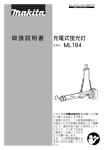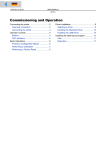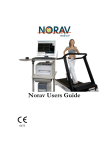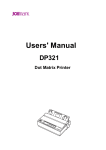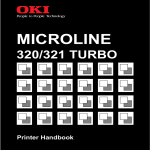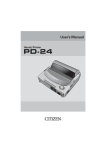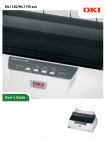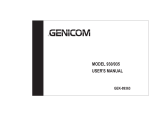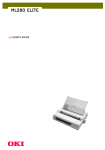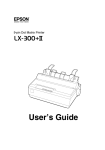Download User Manual - Rice Lake Weighing Systems
Transcript
Every effort has been made to ensure that the information in this document is complete, accurate, and up-to-date. Oki Data assumes no responsibility for the results of errors or omissions beyond its control. Oki Data also cannot guarantee that changes in software and equipment made by other manufacturers and referred to in this document will not affect the applicability of the information in it. Mention of software products manufactured by other companies does not necessarily constitute endorsement by Oki Data. Copyright 2004 by Oki Data. All Rights Reserved Document: MICROLINE ML186 User’s Guide First Edition: January, 2004 Written and produced by the Oki Data Training and Publications Department. Please address any comments on this publication to: Oki Data Americas, Inc. Training and Publications Department 2000 Bishops Gate Blvd. Mount Laurel, NJ 08054-4620 We invite you to visit Oki Data's multilingual web site at: http://www.okidata.com. OKI, Oki Data and MICROLINE are registered trademarks of Oki Electric Industry Company, Ltd. Epson is a registered trademark of Seiko Epson Corporation (SEC), registered in the U.S. and other countries. IBM is a registered trademark of IBM Corporation. LINUX is a registered trademark of Linus Torvalds. Microsoft, MS-DOS, Windows, Windows NT and DOS are either registered trademarks or trademarks of Microsoft Corporation in the United States and/or other countries. Word Perfect is a registered trademark of Corel Corporation. 59358801, Rev. 1.0 Contents Notes, Cautions, etc. . . . . . . . . . . . . . . . . . . . . . . . . . . . . . . . . . 4 Getting Started . . . . . . . . . . . . . . . . . . . . . . . . . . . . . . . . . . . . . . 5 Location . . . . . . . . . . . . . . . . . . . . . . . . . . . . . . . . . . . . . . . . . . 5 Contents and Unpacking . . . . . . . . . . . . . . . . . . . . . . . . . . . . . 5 Removing the Shipping Restraint . . . . . . . . . . . . . . . . . . . . . . . 6 Installing/Replacing the Ribbon Cartridge . . . . . . . . . . . . . . . . 7 Installing the Platen Knob . . . . . . . . . . . . . . . . . . . . . . . . . . . . 10 Adjusting the Head Gap . . . . . . . . . . . . . . . . . . . . . . . . . . . . . 11 Installing the Paper Separator . . . . . . . . . . . . . . . . . . . . . . . . 12 Setting Up Your Printer . . . . . . . . . . . . . . . . . . . . . . . . . . . . . . 13 Power Connection . . . . . . . . . . . . . . . . . . . . . . . . . . . . . . . . . 13 Loading Paper . . . . . . . . . . . . . . . . . . . . . . . . . . . . . . . . . . . . 14 Testing Your Printer . . . . . . . . . . . . . . . . . . . . . . . . . . . . . . . . 29 Computer Connections . . . . . . . . . . . . . . . . . . . . . . . . . . . . . . 30 Setting up the Printer to Work with Your Computer . . . . . . . . 35 Operating Your Printer. . . . . . . . . . . . . . . . . . . . . . . . . . . . . . . 39 Front Panel Operation . . . . . . . . . . . . . . . . . . . . . . . . . . . . . . 39 Setting Printer Defaults. . . . . . . . . . . . . . . . . . . . . . . . . . . . . . 42 Using the Pull Tractor Unit . . . . . . . . . . . . . . . . . . . . . . . . . . . 50 Using the Roll Paper Stand . . . . . . . . . . . . . . . . . . . . . . . . . . 53 Maintenance . . . . . . . . . . . . . . . . . . . . . . . . . . . . . . . . . . . . . . . 57 Replacing the Ribbon Cartridge . . . . . . . . . . . . . . . . . . . . . . . 57 Testing Your Printer . . . . . . . . . . . . . . . . . . . . . . . . . . . . . . . . 59 Cleaning the Housing . . . . . . . . . . . . . . . . . . . . . . . . . . . . . . . 61 Troubleshooting . . . . . . . . . . . . . . . . . . . . . . . . . . . . . . . . . . . . 63 General Information . . . . . . . . . . . . . . . . . . . . . . . . . . . . . . . . 63 Clearing Paper Jams . . . . . . . . . . . . . . . . . . . . . . . . . . . . . . . 69 Parts & Options . . . . . . . . . . . . . . . . . . . . . . . . . . . . . . . . . . . . 78 Replacement Parts . . . . . . . . . . . . . . . . . . . . . . . . . . . . . . . . . 78 Options . . . . . . . . . . . . . . . . . . . . . . . . . . . . . . . . . . . . . . . . . . 79 Specifications . . . . . . . . . . . . . . . . . . . . . . . . . . . . . . . . . . . . . . 80 Index . . . . . . . . . . . . . . . . . . . . . . . . . . . . . . . . . . . . . . . . . . . . . 84 3 Notes, Cautions, etc. Note A note appears like this. It provides additional information which helps you to use and understand the product. Important An important message appears like this. It provides supplemental information which can prevent potential problems. CAUTION! A caution message appears like this. It provides information which, if ignored, can result in equipment malfunction or damage. WARNING! A warning message appears like this. It provides information which, if ignored, can result in the risk of personal injury. 4 • Notes, Cautions, etc. Getting Started Location • Select a firm, solid surface for your printer. • Allow enough space around the printer to easily access the platen knob and the various paper feed paths. • Make sure a suitable grounded power outlet is available nearby. Contents and Unpacking • If any items are missing, contact your dealer immediately. • Keep your packing materials and carton in case you ever need to ship or transport the printer. • Interface cables and paper are sold separately. . 1 ML186 Printer 4 Ribbon Cartridge 2 Paper Separator 5 Power Cord 3 Platen Knob 6 CD 5 • Getting Started Removing the Shipping Restraint Important! Do not plug the printer into the power outlet until the following steps have been completed. 1. Remove any packing tape. 2. Reach into the top cover slot (1) and remove the access cover (2) by lifting it. 3. Remove the printhead shipping restraint. Keep the shipping restraint for future use. 4. Reinstall the access cover. 6 • Getting Started Installing/Replacing the Ribbon Cartridge Use only genuine Oki Data ribbon cartridges. When replacing a ribbon cartridge, make sure you have the correct replacement ribbon for your printer. The wrong ribbon will not print when installed in your printer. Important • Leave unused ribbon cartridges in their packaging until you are ready to install them. • Careful! The ribbon ink can cause permanent stains. • Ribbon ink on skin or clothing can usually be removed with soap and water. 1. Make sure the printer is turned off! WARNING! If the printer has been recently used, the printhead may be HOT! 7 • Getting Started 2. Remove the access cover and center the printhead. 3. If you are replacing the ribbon cartridge, remove the used one: Important Do not remove the ribbon shield (1) from the new ribbon! 8 • Getting Started 4. Unpack the ribbon cartridge and install it on the printhead. Note If the ribbon won’t load easily, turn the take- up knob slightly until the x-shaped notch on the bottom of the ribbon cartridge aligns with the x-shaped insert on the ribbon plate. 5. Press gently on the ribbon cartridge until you feel it click into place. 9 • Getting Started 6. Turn the take-up knob (1) in the direction of the molded arrow to take up any ribbon slack. 7. Replace the access cover. Installing the Platen Knob Align the notch (1) with the pin on the platen shaft and push it firmly into place. 10 • Getting Started Adjusting the Head Gap The head gap is the distance between the printhead and the platen roller. When you use envelopes or multipart forms, you need to have a larger gap than when using plain paper. Use the recommended head gap to ensure the best print quality and easy paper feed CAUTION! Incorrect setting of the head gap can cause printhead damage or ribbon jams. To avoid these problems set the head gap for the type of media being used. To adjust the head gap, move the colored lever (1) located to the left of the ribbon cartridge to the correct position for the type of media being used … …as detailed in the following table: Paper Type Lever Position Single Sheets, up to 20 lb. (75 g/m2) 1 or 2 Forms, 2-part [maximum thickness 0.28 mm] 2 or 3 Forms, 3-part [maximum thickness 0.28 mm] 3 Forms, 4-part [maximum thickness 0.28 mm] 3 11 • Getting Started Installing the Paper Separator The paper separator is used for printing on single sheets (no carbons). With continuous forms paper, it is used to separate the ingoing/outgoing paper to prevent paper jams. 1. Hold the paper separator with the spring-loaded feet down. 2. Place the tabs (1) on the paper separator in the two corresponding slots ( ) on the printer. 3. Press down to release the paper separator onto the printer. 12 • Getting Started Setting Up Your Printer Power Connection 1. Make sure the printer is turned off. 2. Plug the power cord supplied with your printer into the back of the printer. Important The outlet voltage must match the voltage marked on the printer label. 3. Plug the other end of the power cord into an appropriate grounded outlet. 13 • Setting Up Your Printer Loading Paper Three types of paper can be used with your printer: • Continuous Forms Paper (with or without the optional Pull Tractor) • Single Sheets • Roll Paper, using the optional Roll Paper Stand Before You Start 1 2 3 4 5 Bail Arm Lever Bail Arm Paper Lever Platen Knob Head Gap Lever 14 • Setting Up Your Printer Paper Lever Positions = Single Sheet Feed = Continuous Forms Setting the Head Gap Before you load paper, be sure to check the head gap lever setting (see page 11). Important Do not plug the printer into the power outlet until the following steps have been completed. 15 • Setting Up Your Printer Loading Continuous Forms, Rear Feed 1. Make sure the printer is turned off. 2. Place the stack of continuous forms paper behind the printer. 3. Remove the access cover (1). 4. Pull the bail arm lever (2) — on the left side of the printer — toward the front of the printer to lift the bail arm. 16 • Setting Up Your Printer 5. Move the paper lever (3) — on the right side of the printer — toward the front of the printer to the continuous forms symbol. 6. Pull the lock levers (A) on the sprocket wheels at either end of the platen forward, then adjust the sprocket wheels (B) so that the sprockets align with the holes in the continuous forms you are using. 7. Push the levers back to lock the sprocket wheels in position. 17 • Setting Up Your Printer 8. Insert the first sheet of paper between the paper separator guides (5) and push it through the paper separator. 9. Place the paper between the sprocket feed guides (6) and feed it behind the platen, gently positioning it so that its holes engage the sprockets on the ends of the platen. Note Make sure you keep the lead edge of the paper straight so that the sprockets engage the matching pins on either side. Otherwise the paper will feed in skewed and paper jams will occur. 18 • Setting Up Your Printer 10. Turn the platen knob (7) to advance the paper until it appears in front of the platen, behind the bail arm. Important Check to be sure that the matching holes on either side are engaging the sprockets (A). If they are not evenly matched and the paper is skewed (B), back the paper out and try again! 19 • Setting Up Your Printer 11. Push back on the bail arm lever (2) to lower the bail arm. 12. Use the platen knob (7) to set the position of the paper to the first printing line. 13. Replace the access cover, being sure to feed the edge of the paper through the slot in the cover. 14. Turn the printer on. 20 • Setting Up Your Printer Loading Continuous Forms, Bottom Feed 1. Make sure the printer is turned off. 2. Place the printer on a slotted printer stand, carefully aligning the slot in the stand with the slot in the base of the printer. 3. Place a box of continuous forms paper on the stand, under the printer. 4. Remove the access cover (1). 21 • Setting Up Your Printer 5. Pull the lock levers (A) on the sprocket wheels at either end of the platen forward, then adjust the sprocket wheels (B) so that the sprockets align with the holes in the continuous forms you are using. 6. Push the levers back to lock the sprocket wheels in position. 7. Pull the bail arm lever (3) — on the left side of the printer — toward the front of the printer to lift the bail arm. 8. Move the paper lever (4) — on the right side of the printer — toward the front of the printer to the continuous forms symbol. 22 • Setting Up Your Printer 9. Insert the first sheet of continuous forms paper through the opening in the printer stand and into the bottom of the printer, gently feeding it into the printer until it appears in front of the platen, and above the bail arm. Important Check to be sure that the matching holes on either side are engaging the sprockets (A). If they are not evenly matched and the paper is skewed (B), back the paper out and try again! 23 • Setting Up Your Printer 10. Move the bail arm lever (3) back to lower the bail arm. 11. Use the platen knob (5) to advance the paper to the first printing line. 12. Replace the access cover, being sure to feed the edge of the paper through the slot in the cover. 13. Turn the printer on. 24 • Setting Up Your Printer Loading Single Sheets Note Before printing single sheets, you must remove the Pull Tractor or Roll Paper Stand, if installed. Your printer can accommodate single sheets up to 9.5 inches (241 mm) wide. Note In order to use paper wider than traditional letter size, you must move the sprocket wheels to their outermost positions so that the paper does not tear on the sprockets. See the directions below. 1. Turn the printer on. 25 • Setting Up Your Printer 2. Move the paper lever (1) — on the right side of the printer — toward the rear of the printer, to the single sheet symbol. 3. Ensure that the printer is off-line (press SELECT if necessary). 4. If you are using paper wider than 8.5 inches (216 mm), move the sprocket wheels to their outermost position: a. Remove the access cover. b. Pull the lock levers (A) at either end forward and move the sprocket wheels (B) as needed. 26 • Setting Up Your Printer c. Push back on the levers to lock the sprocket wheels in position. 5. Make sure the bail arm lever (2) is set to the rear of the printer (closed position). 6. Raise the paper separator. 27 • Setting Up Your Printer 7. Adjust the sheet guide (3) on the paper separator to position the left edge of the sheet, then insert a single sheet along the guide until it reaches the pinch roller. 8. Pull the bail arm lever (2) toward the front of the printer. The sheet of paper is drawn around the platen. 28 • Setting Up Your Printer 9. Push back the bail arm lever, ensuring that the paper has been positioned correctly. 10.Press SELECT to place the printer on line. Testing Your Printer Your printer has a built-in test (self test) to make sure that it is set up and working correctly. 1. Load continuous forms paper into the printer (see page 14, ff.). 2. Make sure the printer is turned off, then press and hold LINE FEED while turning the printer on. The test print begins. 3. To stop the test, press SELECT or turn the printer off. Important The top of each test printout contains information about your printer. Be sure to have a copy of the printout handy if you have to call for service. 29 • Setting Up Your Printer Computer Connections USB Connection Notes • For connection to a PC running Windows® 98 or above, but not Windows 95 upgraded to Windows 98. • The operation of a printer is not assured if a USB compatible device is connected concurrently with other USB-compatible machines. • When connecting multiple printers of the same type. they appear as *****, *****(2), *****(3), etc. These numbers depend on the order of connecting or turning on of each printer. • USB is a “hot-pluggable” protocol. This means that the printer and computer do not necessarily have to be switched OFF. • Interface cables are not supplied with your printer. USB Cable Requirements • USB 1.1 or higher • Max. length 19.7 ft. (5 m) • USB “B” series connector 30 • Setting Up Your Printer 1. Attach a suitable USB cable to the USB series “B” port on the back of the printer. 2. Connect the other end of the cable to the computer. 3. If you turned the computer and printer off, turn them back on. 31 • Setting Up Your Printer Parallel (LPT) Connection, IEEE-1284 Parallel/USB Model Only Notes • Interface cables are not supplied with your printer. • It is not recommended that you connect parallel and USB cables to the printer simultaneously. Parallel Cable Requirements • bi-directional • max. length 6 ft. (1.8 m) • 36-pin Centronics type connector CAUTION! Make sure the printer and computer are both turned OFF. 1. Turn both the computer and the printer OFF. 32 • Setting Up Your Printer 2. Attach a suitable bi-directional cable to the parallel connector on the back of the printer and secure it with the wire loops. 3. Attach and secure the cable to your computer. 4. Turn the printer and computer back on. Serial (COM) Connection, RS-232C Serial/USB Model Only Notes • Interface cables are not supplied with your printer. • It is not recommended that you connect serial and USB cables to the printer simultaneously. 33 • Setting Up Your Printer Serial Cable Requirements: • Shielded RS-232C cable, UL and CSA approved • Max. length 50 ft. (15 m) • 25-pin serial connector. CAUTION! Make sure the printer and computer are both turned OFF. 1. Switch both the computer and the printer OFF. 2. Plug the cable into the serial port on the back of the printer and tighten the screws. 3. Plug the cable into the computer and tighten the thumbscrews. 4. Turn the printer and computer back on. 34 • Setting Up Your Printer Setting up the Printer to Work with Your Computer Note • Settings made in your software application normally override settings made in your printer driver. • Settings made in the printer driver normally override settings made in the printer menu or via the front panel. Windows XP, 2000, Me, 98, 95, NT 4.0: Install the Printer Driver To print from a Windows-based system, install the printer driver located in the Drivers folder on the CD supplied with your printer. This driver incorporates commands which use the full capability of the printer and automatically switches the printer to the correct emulation regardless of which emulation is selected in the printer menu. 1. Place the CD in your CD-ROM drive. 2. Click Start → Settings → Printers. 35 • Setting Up Your Printer 3. Click Add Printer. The Add Printer Wizard appears. 4. Follow the on-screen instructions. 5. When you get to the window which asks you to select the manufacturer and model of your printer, click Have Disk, then browse to the appropriate directory on the CD and double click the inf file: Windows Version .inf File Location XP \Drivers\WinXP\English\Oemprint.inf 2000 \Drivers\Win2k\English\Oemprint.inf 98 \Drivers\Win98_Me\English\Oemsetup.inf Me \Drivers\Win98_Me\English\Oemsetup.inf 95B [OSR2] \Drivers\Win95\English\Oemsetup.inf NT 4.0 \Drivers\NT40\English\Printer.inf 6. Follow the on-screen instructions to finish loading the driver. Non-Windows Systems: Set the Emulation in the Printer Menu Your printer has three emulations: • IBM® 2480 — the factory default • Epson® ESC/P2 • Oki Data® MICROLINE® Standard If you are using a non-Windows system such as LINUX®, a non-Windows application such as a DOS® program, or an older application such as Word Perfect® 5.1, you need to make sure you have the correct emulation selected in the printer menu (see “Changing the Emulation Default in the Printer Menu” below). If 36 • Setting Up Your Printer you have the wrong emulation selected, you will see strange characters, incorrect fonts, etc. Important See your software documentation for information on how to select an emulation in that application. If you are directly replacing a MICROLINE ML184 Turbo or ML184 printer with the ML186, you must make sure that the printer menu on your new ML186 is set to match the emulation being used for the existing printer (see “Changing the Emulation Default in the Printer Menu” below). For Non-Windows Applications Your printer is compatible with the emulations listed in the table below and will function properly with software developed for them. To make full use of the ML186 printer’s features, use the top entry for the applicable emulation (e.g., IBM 2480). Entries further down (e.g., IBM Graphics Printer Plus, IBM Graphics Printer) work well with the printer, but do not provide full use of the printer’s capabilities. ML186 Emulation Mode Compatible Printers/Drivers IBM IBM 2480 IBM Graphics Printer Plus IBM Graphics Printer Epson Epson ESC/P2 Epson LX Plus Epson LX ML Okidata MICROLINE Standard 37 • Setting Up Your Printer Changing the Emulation Default in the Printer Menu The default for the emulation in the printer menu is IBM. If you wish to change the menu default to another emulation: 1. Make sure continuous forms paper is loaded. 2. Turn the printer off. 3. Press and hold SELECT while turning the printer back on. The printer enters the menu mode. 4. Press FORM FEED. The first line of the menu prints, showing the emulation engaged. For example: Printer Control Emulation Mode IBM 5. Press TOF SET once or twice until the emulation you wish to engage appears in the right-hand column. Each time you press TOF SET, a new line prints and the setting which appears in the last column changes. For example: Printer Control Printer Control Emulation Mode Emulation Mode Epson ML 6. Press PITCH and MODE together to save your setting and exit the printer menu. 38 • Setting Up Your Printer Operating Your Printer Front Panel Operation Front Panel Lights LED Status, Function On = Printer is on line. Off = Printer is off line. Flashing = flashes with ALARM light to indicate a fault has been detected. On, SELECT light off = paper out. On, SELECT light flashing = auto diagnostics have detected an error. Flashing, SELECT light on = printer has overheated. Normal print operation will resume only after a cooling period. On = printer is turned on. Off = printer is turned off. The one lit indicates which character pitch —in characters per inch (cpi)— is engaged. 39 • Operating Your Printer LED Status, Function The one lit indicates which print mode is engaged: NLQ = Near Letter Quality UTILITY = Draft mode HSD = High Speed Draft mode, or SSD (Super Speed Draft) if 12 cpi is selected. 40 • Operating Your Printer Front Panel Buttons Button Print Mode Menu Mode Held at Power Up Advances the paper one line Scrolls through the printer menu groups. Initiates printer Self Test (see page 59). LINE FEED + SELECT = Initiates Rolling ASCII test (see page 60). Advances the paper to the next top of form or ejects single sheet from the printer. Scrolls through the items for each menu group. FORM FEED + SELECT = Places Sets a new top of form (TOF) position. Scrolls through the settings for each item within a group. Sets printer to 17 cpi. Toggles the printer on and off line. Prints list of current menu settings. Places printer in Menu Mode. Selects the character pitch setting (cpi). PITCH + MODE Not applicable. Sets print mode (NLQ, Utility, HSD). PITCH + MODE printer in hex dump mode (see page 60). = save settings and exit to print mode. = save settings and exit to print mode. 41 • Operating Your Printer Not applicable. Setting Printer Defaults The printer has an internal menu containing a number of default parameters which can be set to enable your printer to match the parameters required by your computer. Using the Menu Mode Entering the Menu Mode To enter the Menu Mode, press SELECT while turning on the printer. The 12 and UTILITY LEDs flash. Printing a List of Current Menu Settings With the printer in the Menu Mode, press SELECT to print the complete menu. The current default settings print out. 42 • Operating Your Printer Sample Default Menu Printout Parallel/USB Model Printer Control Emulation Mode IBM Font Font Font Font Font Font Print Mode DRAFT Mode Pitch Proportional Spacing Style Size Utility SSD 10 CPI No Normal Single Symbol Sets Symbol Sets Symbol Sets Symbol Sets Character Set Language Set Zero Character Code Page Set I American Slashed USA Vertical Control Vertical Control Vertical Control Line Spacing Skip Over Perforation Page Length 6 LPI No 11 " Set-Up Graphics Uni-directional Set-Up Receive Buffer Size 64K Set-Up Paper Out Override No Set-Up Print Registration 0 ||||||||||||||||||||| <----- |||||| --------> ||||||||||||||||||| Set-Up Operator Panel Function Full Operation Set-Up Reset Inhibit No Set-Up Print Suppress Effective Yes Set-Up Auto LF No Set-Up Auto CR Yes Set-Up SI Select Pitch (10CPI) 17.1 CPI Set-Up SI Select Pitch (12CPI) 12 CPI Set-Up Time Out Print Invalid Set-Up Auto Select No Set-Up ESC SI Pitch 17.1 CPI Set-Up Impact Mode Normal Parallel I/F Parallel I/F Parallel I/F I-Prime Pin 18 Bi-direction Buffer Print +5v Enable 43 • Operating Your Printer Changing Menu Settings 1. Press SELECT while turning on the printer. 2. Change settings: a. Press LINE FEED to select the relevant group that needs to be changed (the group is the left-hand column on the Menu printout). b. Press FORM FEED to select the relevant item within the selected group (the Item is the center column on the Menu printout). c. Press TOF SET to cycle through the settings available for the item you want to change (the settings are the right-hand column on the Menu printout). d. To continue making changes: • press LINE FEED for the next group or • press FORM FEED for the next item. 3. Repeat the previous step until you are finished changing settings. 4. Press PITCH and MODE together to save the changes you have made and exit the Menu Mode. Important Exiting the Menu Mode by turning off the printer will cancel any changes you have made. 44 • Operating Your Printer For Example The default setting for the zero character is slashed. To change the setting to unslashed: 1. Press and hold SELECT while turning the printer on. The following line prints: Printer Control Emulation Mode IBM 2. Press LINE FEED several times until the Symbol Sets group line appears: Symbol Sets Character Set SetI 3. Press FORM FEED repetitively until the Zero Character item line appears: Symbol Sets Zero Character Slashed 4. Press TOF SET once. The following line prints: Symbol Sets Zero Character Unslashed 5. Press PITCH and MODE together to save the setting and exit the Menu Mode. 45 • Operating Your Printer Default Menu Selections Default settings are indicated in bold italic. Group Item Setting Printer Control Emulation Mode IBM, Epson, ML Font Print Mode Utility, NLQ Courier, NLQ Gothic, Draft (Font) DRAFT Mode HSD, SSD (Font) Pitch 10 CPI, 12 CPI, 15 CPI, 17.1 CPI, 20 CPI (Font) Proportional Spacing No, Yes (Font) Style Normal, Italics (Font) Size Single, Double Selects both double width and double height characters or single width and single height characters. 46 • Operating Your Printer Group Item Setting Symbol Sets Character Set Set I, Set II, Standard, Line Graphics, Block Graphics (ML mode only) (Symbol Sets) Language Set American, French, German, British, Danish I, Swedish, Italian, Spanish I, Japanese, Norwegian, Danish II, Spanish II, Latin American, French Canadian, Dutch, Publisher (Symbol Sets) Zero Character Slashed, Unslashed (Symbol Sets) Code Page USA, Canada French, Multilingual, Portugal, Norway, BRASCII, Abicomp, Multilingual 858, ISO8859-15 Vertical Control Line Spacing 6 LPI, 8 LPI (Vertical Control) Skip Over Perforation No, Yes (Vertical Control) Page Length 11”, 11-2/3”, 12”, 14”, 17”, 5”, 3”, 3.25”, 3.5”, 4”, 5.5”, 6”, 7”, 8”, 8.5” Set-Up Graphics Bi-directional, Uni-directional (Set-Up) 7 or 8 Bits Graphics 8, 7 ML emulation only. (Set-Up) Receive Buffer Size 1 Line*, 32K, 64K, 128K * When 1 Line is selected, the receive buffer size is 2K bytes. (Set-Up) Paper Out Override No, Yes 47 • Operating Your Printer Group Item Setting (Set-Up) Print Registration 0.25 mm Right, 0.20 mm Right, 0.15 mm Right, 0.10 mm Right, 0.05 mm Right, 0, 0.05 mm Left, 0.10 mm Left, 0.15 mm Left, 0.20 mm LEft, 0.25 mm Left (Set-Up) 7 or 8 Bits Data Word 8, 7 ML emulation only. (Set-Up) Operator Panel Function FULL OPERATION, Semi Operation*, Limited Operation * When Limited Operation is selected, after exiting the Menu, only the SEL, LINE FEED and FORM FEED buttons operate. The PRINT QUALITY, TOF and PITCH buttons are inactive. (Set-Up) Reset Inhibit No, Yes (Set-Up) Print Suppress Effective No, Yes (Set-Up) Auto LF No, Yes (Set-Up) Auto CR No, Yes (Set-Up) SI Select Pitch (10 CPI) 15 CPI, 17.1 CPI (Set-Up) SI Select Pitch (12 CPI) 12 CPI, 20 CPI (Set-Up) TIme Out Print Valid, Invalid (Set-Up) Auto Select No, Yes (Set-Up) ESC SI Pitch 17.1 CPI, 20CPI 48 • Operating Your Printer Group Item Setting (Set-Up) Impact Mode Normal, Quiet Parallel I/F I-Prime Invalid, Buffer Print, Buffer Clear (Parallel I*/F) Pin 18 +5v, Open (Parallel I*/F) Auto Feed XT Valid, Invalid (Parallel I/F) Bi-Direction Enable, Disable Serial I/F Parity None, Odd, Even (Serial I/F) Serial Data 7 or 8 Bits 8 bits, 7 bits (Serial I/F) Protocol Ready/Busy, X-ON/X-OFF (Serial I/F) Diagnostic Test No, Yes (Serial I/F) Busy Line SSD-, SSD+, DTR, RTS (Serial I/F) Baud Rate 19,200 bps, 9600 bps, 4800 bps, 2400 bps, 1200 bps, 600 bps, 300 bps (Serial I/F) DSR Signal Valid, Invalid (Serial I/F) DTR Signal Ready on Power Up, Ready on Select (Serial I/F) Busy Time 200 ms, 1 sec Only appears for printers equipped with Parallel Interface. Only appears for printers equipped with Serial Interface. 49 • Operating Your Printer Using the Pull Tractor Unit (if installed) Paper can be loaded from the rear of the printer or, if you have a slotted printer stand, it can be loaded from the bottom. 1. Remove the acoustic cover (1) and access cover (2). 2. Adjust the left tractor if necessary, making sure that it is not more than ½-inch (12.7 mm) from the left end of the tractor unit. To move the tractor, pull the lock lever (1) forward, slide the tractor to the desired position, then push the lever back to lock it in place. 50 • Operating Your Printer 3. Adjust the right tractor to the paper width by pulling its lock lever (1) forward, sliding the tractor to the desired position, then pushing the lever back to lock it in place. 4. Pull the paper under the bail arm and up to the level of the tractor unit. 5. Open the sprocket covers (A) at either end of the pull tractor. 6. Pull the paper lever (on the right side of the printer) forward to the continuous forms position. 51 • Operating Your Printer 7. Place the holes in the paper over the sprockets on the pull tractor unit and close both sprocket covers. Note Be careful to align the paper properly so that an equal number of holes are engaged on the sprockets at either end of the pull tractor. Misalignment will cause paper jams and/or ripping. 8. Replace the access cover and acoustic cover. 52 • Operating Your Printer Using the Roll Paper Stand (if installed) Loading the Paper Correct Paper Path 1 Paper Roll 2 Roll Paper Stand 3 Paper Guide 4 Platen 5 Paper Separator 1. Remove the access cover from the printer. 2. Place the paper lever (right side of printer) in the single sheet position (back) and the bail arm lever (left side of printer) toward the front of the printer (bail arm raised away from platen). 53 • Operating Your Printer 3. Open the paper separator (1). 4. Remove the paper roller. Note that there is a disk (2) on the left end of the roller. 5. Slide the roller into a roll of paper, making sure that the disk (2) is on the left side and that the paper rolls up from the bottom. 54 • Operating Your Printer 6. Put the paper roller back into the stand, with the disc (2) on the left side. 7. Feed the paper over (not under!) the roller (3) on the stand, adjusting the round paper guides on either end (4) to the paper width. 8. Feed the paper down behind the platen and use the platen knob to bring the paper through the printer. Feed the paper in as straight as possible. 9. Continue to feed the paper through for approximately 4 inches (102 mm). 55 • Operating Your Printer 10. Pull the paper lever (right side of printer) toward the front of the printer—to the continuous forms position—and make sure the paper is straight by adjusting it to align the left and right sides behind the platen with the sides in front of the platen. Important Be sure that the paper covers the groove in the left end of the platen so that it clears the paper out detector. 11. Push the paper lever back to the single sheet position to reapply pressure on the platen. 12. Push the bail arm lever (left side of printer) back to close the bail arm. 13. Replace the access cover: a. Fit the cover tabs into the slots at the printer front. b. Lower the cover carefully, making sure the paper fits through the front slot in the access cover. 14. Lower the paper separator so that paper enters the printer from under the separator and exits the printer going over the separator (see “Correct Paper Path” diagram on page 53). 15. Turn the platen knob to move the paper to the point where you want printing to start. (Many word processing packages automatically allow for a top margin of 1 inch [25 mm]). Note To save this position as the permanent Top of Form, press the TOF button. 56 • Operating Your Printer Maintenance Replacing the Ribbon Cartridge For more details, see page 7. WARNING! If the printer has been recently used, the printhead may be HOT! Turn the printer off! 57 • Maintenance 58 • Maintenance Testing Your Printer Self Test (Font Samples) Your printer has a built-in test (self test) to make sure that it is set up and working correctly. 1. Load continuous forms paper into the printer (see page 14, ff.). 2. Make sure the printer is turned off, then press and hold LINE FEED while turning the printer on. The test print begins. 3. To stop the test, press SELECT or turn the printer off. Note The top of each test printout contains information about your printer. Be sure to have a copy of the printout handy if you have to call for service. 59 • Maintenance Rolling ASCII Test The Rolling ASCII Test produces a continuous sampling of ASCII characters using the default type style. To run the test: 1. Make sure continuous forms paper is loaded. 2. With the printer turned off, press and hold SELECT and LINE FEED while turning the printer on. The Rolling ASCII Test begins. 3. To stop the test, press SELECT or turn the printer off. Hex Dump Mode In Hex Dump Mode, all data sent to the printer, including text and printer commands, prints in both hexadecimal and ASCII format. • To place the printer in the Hex Dump Mode, press and hold SELECT and FORM FEED while turning the printer on. • To disengage the Hex Dump Mode, turn the printer off, then on again. 60 • Maintenance Cleaning the Housing CAUTION! Never use solvents or strong detergents on the cabinet: they could damage the housing. You should clean the printer every six months (or after about 300 hours of operation). 1. Turn the printer off. 2. Remove any paper from the path. 3. Remove the access cover. (1) 4. Pull the bail arm lever (2) forward to lift the bail arm. 5. Use a clean, dry cloth to dust around the carriage shaft and platen. 6. Remove any loose bits of paper. 61 • Maintenance 7. Push the bail arm lever back and reinstall the access cover. 8. Reload paper. 9. Turn the printer on. 62 • Maintenance Troubleshooting General Information Here are some general things to check before proceeding with detailed troubleshooting. • Is the printer plugged in and turned on? • Are the connections (power and interface) secure? • Is the printer being operated under the proper ambient conditions (see page 82)? • Does the paper being used meet the specifications for this printer (see page 81)? • Is the paper properly installed (see pages 14, ff.)? • Is the ribbon properly installed (see pages 7, ff.)? • Is an Oki ribbon being used? • Is the head gap correctly set (see page 11)? • Are the correct printer drivers being used for the printer (see page 35)? Note • Settings made in your software application normally override settings made in your printer driver. • Settings made in the printer driver normally override settings made in the printer menu or via the front panel. 63 • Troubleshooting General Problems/Solutions Problem ____________________________________________ My word processor files do not print the way I have the menu and front panel set. Solution 1. Check your software application and/or printer driver settings: these override the menu and front panel settings (see Note above). 2. Before sending a file to the printer, many word processors send either an “initialization string” or an I-Prime signal to the printer. The initialization string contains codes that override the panel and menu settings. To change your printer to ignore the reset code, enter the Menu Mode, go to the Set-Up group and change the setting for Reset Inhibit to Yes. The I-Prime signal will automatically override any front panel settings you have made. To eliminate this problem, enter the Menu Mode, go to the Parallel Interface group and change the setting for I-Prime to Invalid. For more information on changing menu settings, see page 42. Problem ____________________________________________ Nothing happens when I turn on the printer. Solution 1. Check the power cord connection to the outlet and to the printer. 2. If you are using a power strip, make sure it is turned ON, and that the fuse hasn’t blown or that the circuit breaker hasn’t tripped. 3. If the solution is not obvious — call for service. 64 • Troubleshooting Problem ____________________________________________ The printer does not print when the computer sends data. Solutions 1. Is the SELECT light on? If not, press SELECT. 2. Check that the interface cable is securely connected to both the printer and the computer. 3. If you have the optional serial interface board installed, check to be sure that it is firmly seated in the printer and that the interface cable is securely connected to both the printer and the computer. Problem ____________________________________________ I'm getting strange symbols, incorrect fonts, etc., when I try to print a document. Solutions 1. Check to be sure that the printer driver you have selected in your software matches the printer emulation: see “Follow the on-screen instructions to finish loading the driver.” on page 36 and “Changing Menu Settings” on page 44. 2. If you have embedded any printer commands in your software, check to be sure that you entered them correctly. 65 • Troubleshooting Problem ____________________________________________ Ink smears on the paper when I print narrow columns. Solutions The head gap could be too close. Check that the Head Gap Lever (1) is set correctly (see “Adjusting the Head Gap” on page 11). Problem ____________________________________________ I've installed a new ribbon and the printing is smeared and streaked. Solution The ribbon shield (1) is either loose or missing. 1. Remove the ribbon cartridge and check the ribbon shield. 2. If it is loose, secure it. 3. If it is missing, find it and install it. If you cannot find it, see if you have an old ribbon cartridge with the shield still on it. If so, remove the shield from it and put in on the current ribbon cartridge. If not, replace the ribbon cartridge. 66 • Troubleshooting Problem ____________________________________________ There are dots missing in my printouts (typically, tops and /or bottom of characters missing). Solution The head gap may not be set correctly. Try moving the Head Gap Lever (1) to a lower setting. If that doesn’t help, the printhead may be damaged; call for service. Problem ____________________________________________ The ALARM light is flashing. Solution Try turning the printer off, then back on again. If the light still blinks, call for service. Problem ____________________________________________ The Print Quality and Character Pitch keys on the front panel don't work. Solution The Operator Panel Function in the printer menu can be used to disable these buttons (Limited Function). If the printer is part of a customized system or if it is used by a number of people, the system manager may have used this option to make sure the printer is always set properly. Check with your system manager before changing any menu settings. 67 • Troubleshooting Problem ____________________________________________ My printer keeps indicating “Paper out” even though there is paper installed. Solution The most likely cause is that the paper sensor groove at the left end of the platen is not covered by the paper. Move the paper over to cover the sensor groove. Problem ____________________________________________ When I am using continuous feed paper, the sprocket holes are torn, causing alignment problems. Solution The most likely cause is that the paper lever (right side of printer) is in the single sheet position. Make sure the lever is in the continuous forms position (forward). 68 • Troubleshooting Clearing Paper Jams Rear Feed Jams 1. Turn the printer off. 2. Use the platen knob to back the paper all the way out of the printer. 69 • Troubleshooting CAUTION! Make sure the printer is turned OFF before you remove the access cover. 3. Remove the access cover (1). 4. Move the bail arm lever (2) toward the front of the printer to open the bail arm. WARNING! The printhead may be HOT! 5. Remove any torn paper. 6. Reload the paper (see pages 14, ff.). 70 • Troubleshooting 7. Move the bail arm lever (2) towards the rear of the printer and replace the access cover (1) being sure to feed the edge of the paper through the slot in the cover. 8. Turn the printer on. 71 • Troubleshooting Rear Feed, Repeating Paper Jams If the paper keeps jamming, you may have: • defective paper • misaligned paper • bits of paper in the paper path For Defective Paper Replace the defective paper with a fresh stack. For Misaligned Paper 1. Turn the printer off. 2. Use the platen knob to back the paper all the way out of the printer. 3. Tear off a couple of sheets of paper, leaving a new, clean, square-cut edge. 72 • Troubleshooting 4. Reload the paper. 5. Turn the printer back on. For Bits of Paper in the Paper Path 1. Turn the printer off. 2. Remove any accessories. 73 • Troubleshooting 3. Use the platen knob to back the paper all the way out of the printer. CAUTION! Make sure the printer is turned OFF before you remove the access cover. 4. Remove the access cover. 5. Remove any debris from the paper path. 6. Replace the access cover and any accessories which you removed. 74 • Troubleshooting 7. Reload the paper. 8. Turn the printer on. 75 • Troubleshooting Single Sheet Paper Jams 1. Turn the printer off. 2. Use the platen knob to back the paper out. CAUTION! Make sure the printer is turned OFF before you remove the access cover. 3. Remove the access cover. WARNING! If the printer has been recently used, the printhead may be HOT! 4. Remove any torn pieces from around the carriage. 76 • Troubleshooting 5. Replace the access cover. 6. Turn the printer back on. 7. Reload the paper. 77 • Troubleshooting Parts & Options Replacement Parts Ribbon Cartridge (Oki 52102001) Platen Knob (Oki 53459807) Power Cord (Oki 56609701) Access Cover (Oki 53467410) Paper Separator (Oki 53459303) 78 • Parts & Options Options Pull Tractor (Oki 70009701) Includes Pull Tractor (1), Acoustic Cover (2) and Access Cover (3). Roll Paper Stand (Oki 70007701) 79 • Parts & Options Specifications General Print Method Impact dot matrix Printhead 9 pins, 0.30 mm (0.0118") diameter, with thermal protection Emulations (co-resident) IBM 2480 Epson ESC/P2 Okidata MICROLINE Standard Print Speed, characters per second (cps) Super Speed Draft (SSD) High Speed Draft (HSD) Utility (UTL) Near Letter Quality (NLQ) 375 cps (12 cpi only) 333 cps 250 cps 62.5 cps Buffer size 128 Kb 80 • Specifications Paper Type Feed Weight Width Cut Sheets Top only 16 to 21 lb. US Bond (60 to 81 g/m²) 3" to 9.5" (76 to 241 mm) Continuous, Single Part Rear/Bottom 14 to 20 lb. US Bond (53 to 75 g/m²) 3‘” to 9.9" (76 to 251 mm) Continuous, Multipart • 4 sheets (orig.+3), Carbonless • Up to 0.11" (0.28 mm) thick Rear/Bottom 14 to 20 lb. US Bond (53 to 75 g/m²) 3‘” to 9.9" (76 to 251 mm) Reliability Ribbon Life 3 million characters, on average Printhead Life 200 million characters average in 10 cpi utility mode Mean Time Between Failures (MTBF) 20,000 hours at 25% duty cycle and 35% page density Mean Time to Repair (MTTR) 15 minutes 81 • Specifications Physical Height 3.15" (80 mm) Width 14.65" (372 mm) Depth 10.83" (275 mm) Weight 9.9 lb. (4.5 Kg) Electrical Voltage 120V, +6%, -15% 230V, +15%, -14% Frequency 50 or 60 Hz, ±2% Environmental Temperature Operating Storage 41 to 104°F (5 to 40°C) -40 to 158°F (-40 to +70°C)) Humidity Operating Storage 20 to 80% RH 5 to 95% RH Noise level Normal: Less than 54 dBA Quiet Mode: Less than 51 dBA 82 • Specifications Interfaces Parallel Models Centronics Parallel, IEEE-1284 compliant USB 1.1 Serial Models RS-232C Serial USB 1.1 83 • Specifications Index E A Access cover replacement # ...........................78 ALARM light ...................................39 B Bail arm ............................................14 Bail arm lever .................................14 Bottom feed paper loading ...................................21–24 Buffer size .......................................80 Buttons, front panel ......................41 C Caution boxes .................................. 4 Cleaning the housing ..................61 Computer connections parallel ...................................32–33 serial ......................................33–34 USB ..............................................30 Continuous forms loading bottom feed .....................21–24 rear feed ..........................16–20 specifications .............................81 Cut sheet paper ............................81 D Default menu settings ............................46 Defaults ......................................42–43 menu mode ..........................48–49 Dimensions .....................................82 Drivers, printer ...............................35 Electrical specifications .............. 82 Emulations ................................36, 80 Environmental specifications .... 82 F FORM FEED button .................... 41 Frequency ....................................... 82 Front panel ...............................39–41 buttons ........................................ 41 lights ......................................39–40 G Gap, printhead .............................. 11 H Head gap ........................................ 11 lever ............................................. 14 Hex dump mode ........................... 60 Humidity specifications ............... 82 I Important boxes .............................. 4 Interfaces parallel ........................................ 83 serial ............................................ 83 USB .............................................. 83 I-Prime ............................................. 49 J Jams, paper rear feed ...............................69–75 single sheet .........................76–77 K Knob, platen ................................... 10 84 • Index L LEDs, front panel ....................39–40 Levers ..............................................14 Lights, front panel ...................39–40 LINE FEED button ........................41 Loading paper ..........................14–29 Location ............................................. 5 M Menu changing settings ...............44–45 default settings ...................48–49 defaults .......................................43 settings ........................................42 settings, changing ...................44 Menu mode ..............................42–49 MODE button .................................41 Mode lights .....................................40 N Noise level specifications ...........82 Notes .................................................. 4 O Options pull tractor ..................................79 roll paper stand .........................79 P Paper jams rear feed ...............................69–72 single sheet .........................76–77 Paper lever .....................................14 Paper loading continuous forms ...............14–24 bottom feed .....................21–22 rear feed ..........................16–20 single sheets .......................25–29 Paper separator installing ...................................... 12 replacement # ........................... 78 Paper specifications .................... 81 Parallel computer connection ........32–33 interface menu settings ......... 49 PITCH button ................................. 41 PITCH lights ................................... 39 Platen knob .................................... 10 replacement # ........................... 78 Power connection ......................... 13 Power cord replacement # ........................... 78 POWER light .................................. 39 Print speed ..................................... 80 Printer defaults ....................................... 42 dimensions ................................ 82 drivers ......................................... 35 emulations ................................. 36 reliability ...................................... 81 weight .......................................... 82 Printhead ......................................... 78 gap ............................................... 11 life ................................................. 81 shipping restraint ....................... 6 specifications ............................ 80 Pull tractor ...................................... 79 using ......................................50, 52 85 • Index R T Rear feed paper loading ...................................16–20 Reliability .........................................81 Replacement parts .......................78 Ribbon cartridge installing ........................................ 7 life .................................................81 replacement # ...........................78 replacing .................................7, 57 take-up knob .............................10 Ribbon shield ................................... 8 Roll paper stand ............................79 using ......................................53–56 Rolling ASCII test .........................60 Take-up knob, ribbon .................. 10 Temperature specifications ....... 82 Testing ............................................. 29 Tests font sample ................................ 59 hex dump mode ....................... 60 Rolling ASCI .............................. 60 self test ....................................... 59 TOF SET button ........................... 41 S Voltage ............................................. 82 SELECT button .............................41 SELECT light .................................39 Self test ......................................29, 59 Separator, paper ...........................12 Serial interface connection ............................33–34 menu settings ............................49 Shipping restraints ......................... 6 Single sheet paper loading ...................................25–29 specifications .............................81 Specifications ...........................80–83 W U Unpacking ......................................... 5 USB connection ......................30–31 V Warning boxes ................................ 4 Weight .............................................. 82 86 • Index






















































































